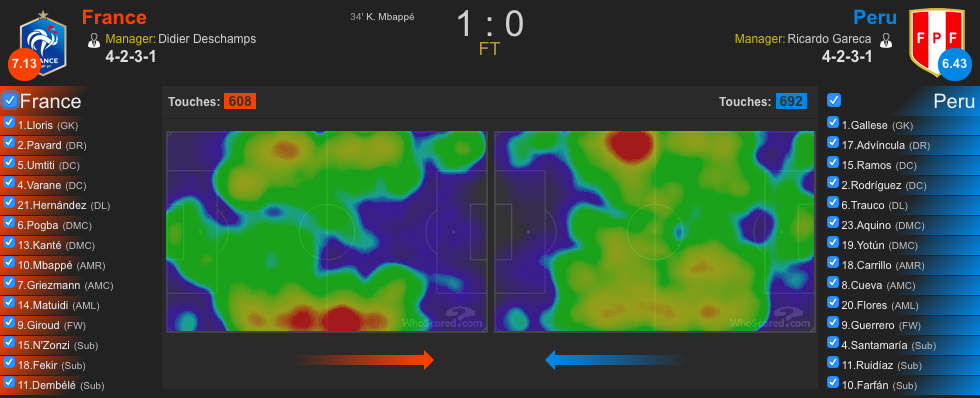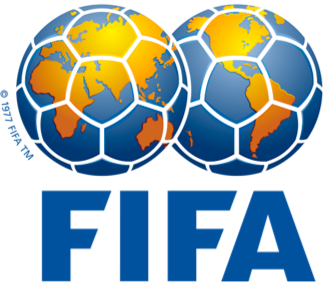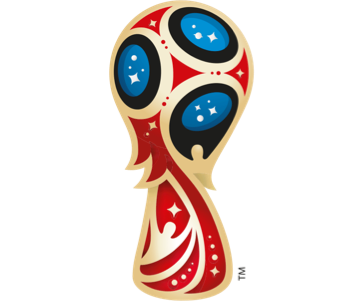
In the 26th minute of a March 23 friendly against Colombia, I saw a glimpse of what I believed would be the most exciting team in the World Cup.
France had just completed a slick, free-flowing passing sequence from one side of the 18-yard box to the other, including a back-heel flick from Antoine Greizmann and a shot-fake from Kylian Mbappe, leaving a Colombian defender sliding at air. Mbappe set up Thomas Lemar, who rifled a shot into the side netting. 2-0, France. It was so smooth. So precise.
“What team in the world could stop that?” I thought to myself.

Well, it turns out France’s Group C opponents never had to worry about curtailing a high-octane attack.
So far this World Cup, I’ve been sensing a degree of fear emanating from France coach Didier Deschamps in the way he has been choosing his formations and lineups. Throughout its squad, France arguably has the most dynamic attack in the World Cup, with Brazil as its only rival. Yet, it seems like Deschamps is trying to find ways to dampen his team’s attacking enthusiasm.
His plan is working. France played to a dull 0-0 draw with Denmark in what was the first scoreless game of the tournament. The result ensured France and Denmark would advance to the Round of 16 as group winner and runner-up, respectively. Deschamps made six changes to his lineup Tuesday, protecting players on yellow cards (Paul Pogba, Corentin Tolisso and Blaise Matuidi) and giving some others a chance to rest (Hugo Lloris, Benjamin Pavard, Samuel Umtiti and Mbappe). Frankly, neither team had much incentive to win, and it showed.
Entering its knockout game against Argentina, France and it’s star-studded attack has only scored three goals this World Cup, two of which were off a penalty kick and a deflection own goal in its opening game against Australia.
The goals weren’t pretty, but France showed flashes of what its attack can do during both of those goals. The first showed France’s ability to get the ball forward with pace through incisive ground passes into space. N’Golo Kante beats a pressing defender in his own third of the field and releases Pogba in the midfield, who then releases Greizmann beyond Australia’s back four, resulting in a foul and penalty kick. The second goal exhibited how France can play with a target man up front who will combine with attackers making runs into pockets of space. After a give-and-go with Mbappe, Pogba hits it forward to striker Olivier Giroud. Giroud waits for a moment before serving the ball to Pogba atop the 18-yard box. A weird deflected toe-poke-turned-chip follows, giving France a winning goal.
Deschamps played a 4-3-3 in it’s slim victory against Australia, giving Pavard, Lucas Hernandez and Tolisso surprise starts. Deschamps followed with a 4-2-3-1 against Peru — the same formation used against Colombia in March. Greizmann played just below target striker Olivier Giroud, who would hold up play and try to link with Greizmann and Mbappe. It was beginning to look like a more adventurous lineup. But Deschamps pumped the breaks, starting usual box-to-box center midfielder Blaise Matuidi at left attacking midfielder, a position where Lemar would usually start.
This move was likely meant to counter Peru’s dangerous right side of Andre Carrillo and Luis Avincula. An understandable precaution, but it left France with no bite on the left side of its attack, forcing it to attacking on its right wing much more often.

Ultimately, France got its goal off a counter-press from Pogba, who released Giroud. The big man’s bouncing shot may or may not have been heading toward goal before Mbappe tapped it in.
That 1-0 victory sealed France’s place in the knockout stages, allowing Deschamps to make much fewer risks against Denmark. From the starting whistle, the Danes, which played a compact 4-3-3 that sat above the 18, never seemed willing to test the French, either. Lemar did little in his first World Cup start and, as expected, a double-pivot of Kante and Steven Nzonzi lacked in playmaking ability. As such, this game was one of the most uneventful matches in the World Cup.
Despite my displeasure with France’s tactics so far in Russia, I can’t say I blame Deschamps. You know that friendly against Colombia that made me fall in love with this swashbuckling French side? It ended up losing that game in its home country, 3-2.
Two minutes after France’s beautiful second goal, Matuidi and Raphael Varane were caught ball-watching on a manageable low cross. Goalkeeper Hugo Lloris could’ve easily caught Luis Muriel’s pass, as well. None of those things happened. In the second half, Kante committed a live-ball turnover, which eventually led to a Radamel Falcao goal on a four-vesus-three counterattack. France tried to pushing to recover the lead, but its attack wasn’t connecting like the first half. It was only a matter of time until Colombia got the winner, which came by way of a Juan Quintero penalty kick in the 85th minute.
If I were to guess, this game left an impression on Deschamps. They’re not out to please its fans with relentless, dynamic attacking soccer right now. And the former France captain is doing all he can to make sure his team doesn’t get tempted. Whether that’s by favoring less attack-minded side backs (Pavard and Hernandez) or playing Pogba in a double-pivot with Kante, Deschamps has made it clear: results come first. That’s not going to change against Argentina. Lionel Messi and company will be ready to pounce on a team leaving itself too open.
But I would still love to see how badly France could torment Argentina’s lackluster defense if Deschamps let his team loose. At this point, however, that’s looking more like a dream than a realistic possibility.






